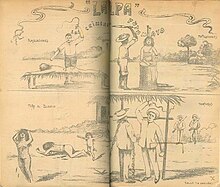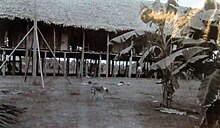 | Draft article not currently submitted for review.
This is a draft Articles for creation (AfC) submission. It is not currently pending review. While there are no deadlines, abandoned drafts may be deleted after six months. To edit the draft click on the "Edit" tab at the top of the window. To be accepted, a draft should:
It is strongly discouraged to write about yourself, your business or employer. If you do so, you must declare it. Where to get help
How to improve a draft
You can also browse Wikipedia:Featured articles and Wikipedia:Good articles to find examples of Wikipedia's best writing on topics similar to your proposed article. Improving your odds of a speedy review To improve your odds of a faster review, tag your draft with relevant WikiProject tags using the button below. This will let reviewers know a new draft has been submitted in their area of interest. For instance, if you wrote about a female astronomer, you would want to add the Biography, Astronomy, and Women scientists tags. Editor resources
Last edited by Citation bot (talk | contribs) 39 hours ago. (Update) |
The Matanzas rubber station was established at the end of 1904 by Larranaga, Arana y Company. Matanzas was considered one of the "in land" stations of Arana's company, and natives from the Bora, Andoque, and Muinane and Manuyas nations were dedicated to the extraction of rubber here.
. edit
The term Matanzas may translate to "Massacres"[1] or "Slaughters" in Spanish.[2][3]
October of 1904 : Abandoned after October of 1910 December of 1904[4]
1904-1905 edit

Citation for Normand leaving Chorrera on November 17 1904, along with a Barbadian deponent.[5] - Leavine provides the date?
The station of Matanzas was established in 1904 as a business venture between Larranaga, Arana y Company and Ramon Sanchez, a partner in the firm. - Parliamentary Papers V. 14 page 614
Augustus Walcott stated that sixteen chained natives assisted with the construction of Matanzas in 1904.[6]
-Abuse of Quintin by Normand + Sanchez, twice.[4]
-Augustus Walcott was also abused by Normand, at the end of 1904 or at the beginning of 1905. Normand had Walcott "hung up by his arms tied behind his back for a very long time, and beaten with swords or machetes."[7] There was another Barbadian, named James or Percy Francis, that was tied up and flogged under orders from Sanchez.[8]
JOSHUA DYALL provided a list of names regarding the twenty five Barbadians[a] that were sent with him to Matanzas.[10] Dyall was employed with the very first contingent of Barbadians, which was accompanied by Armando Normand.[12] Dyall believed that each man was armed and had received 100 bullet cartridges. Ramon Sanchez was in charge of this group, and the establishment of the Matanzas station.[10]Augustus Walcott stated that sixteen chained natives assisted with the construction of Matanzas in 1904.[6] The "punitive expeditions" and slave raids were ordered by Sanchez, "Gleeman and Cordoba"[b] shortly after the contingents arrival in the area.[14]
^Gleeman may be Glieman, an Argentinian.
Corroboration source for the first contingent of Barbadians, thirty men and five women, arriving at La Chorrera in November of 1904. "Here they were armed with Winchester rifles and a large supply of cartridges for these weapons,"[15]
When the expedition arrived at the location of Matanzas, there was a single "palm-thatched" indigenous hut. There were eight men assigned as guards throughout the night. [10]
"Then they cut posts and trees and dug holes and built a house, and then they would be sent out with their rifles to look for the Indians and try to catch them. They were ordered by the manager, Senor Sanchez, and by Gleeman and Cordoba, who used to lead them on these expeditions, that if they could not catch the Indians they were to fire on them. Asked why this was done, he said it was to frighten the Indians and make them come in, because if they were killed for running away they would be less likely to run." [16]
^*"On arrival in this region the men were employed at first in building a house, and then on raids through the surrounding forests in order to capture Indians and compel them to come in and work for Senor Sanchez." [15]
See [17] for killings by Ramon Sanchez, reported by Clifford Quintin in 1910.
1906-1909 edit


-Caporo deposition, recounts correria on June 15, 1907.[18]
-Rubber marched from Matanzas to Puerto Peruano, then it is shipped to La Chorrera.[19][20][21]
In 1907, Arana's company launched the steamship Veloz on the Igaraparana River, above La Chorrera.[22] The establishment of this steamship service shortened the journey for natives traveling between Matanzas and La Chorrera, however rubber was still transported with an armed escort forty-five to fifty miles through the forest.[23][20]
-Muriedas claim of 200 whip lashes given to natives who do not meet rubber quota.[24] Corroboration from Leavine.[25][c]
-Nequen burnt by kerosine oil.[26]
-See [27] for deposition of Antonio Galvez, recounts punishment for a missed quota. Claims natives were left almost dead after punishment. Wounds washed with salt and capsicum
"The Matanzas section is the worst of all. Here are concealed hundreds of skeletons of the victims of the ferocious Normand, a youth who is less than 22 years of age."[28] - Saldana
-"Great Caqueta Rebellion" resulted in the destruction of an outpost that was established for Matanzas, and the death of four(?) PAC employees, including Bucelli. The mutiny was perpetrated by four muchachos de confianzas.[29]
1910-1911 edit





Casement estimated that the distance from La China to Matanzas was thirty miles away, or ten hours of marching.[30]
After Casement took depositions at Matanzas, Tizon promised to dismiss the entire staff for the stations of Matanzas and La China, along with several other in land stations.[31]
Normand told Casement that Matanzas did not have a scale, and the rubber was either weighed at La China or a house located in the forest.[32]
"Dr Paredes declares that he himself certified to the murder of no less than 1000 people in the actual station house of Andokes or Matanzas - Normand's headquarters. This in no wise represented all the massacres perpetrated by that monster or his section, but only the deaths that Dr. Paredes became convinced of as having taken place in close proximity to the house itself. The bones he says he found in heaps - some in the bed of a stream - others in a deep pit that had been dug to receive them when it was known that I might visit Andokes - and others lined the paths through the forest in certain directions... The crimes he attributes to Normand are worse even than I realised. He adds, too, that the outraging of children, of even very small children, was frequently practised by these men and that these innocent victims of this atrocious lust were killed or died from the effects of outrages committed upon them.[33]
TWENTY FIVE BARBADIAN MEN SENT TO MATANZAS IN 1904, TEN NON BARBADIAN MEN INCLUDED.
The 1910 Fabrico brought to Matanzas yielded around 8 tons of rubber and was delivered by around 200 Boras and Andoque natives from the surrounding area.[34][d]
In 1910 Normand claimed that the natives at his station had not been punished by flagellation for two years.[36]
Leavine stated that in 1906 and 1907, there were days "when you could not eat your food on account of the dead Indians lying about the house."[37]
Correria in 1910 mentioned.[38]
Normand was officially dismissed from the Peruvian Amazon Company by Tízon on February 14, 1911[39] and Cesar Bustamente succeeded him as manager of Matanzas.[40][41]
An employee Juanito Rodriguez was originally supposed to replace Normand as manager, however Normand told the natives that Juanito would continue to abuse them and as a result one indigenous nation had fled. Casement believed that Normand told this to the natives so that Rodriguez would bring in a poor haul of rubber. [42]
Notes edit
- ^ Dyall stated that the first contingent was composed of thirty Barbadian men and five women.[9] Dyall stated that there were between ten to fifteen white men accompanying the Barbadians.[10] Westerman Leavine's deposition revealed the five women were Barbadian as well.[11]
- ^ Gleeman is a name that only appears once in the Putumayo bibliography, and his first name is unknown.[10] Cordoba, appears to be José Cordoba, a name appears in Westerman Leavine's deposition regarding the flagellation of Kodihinka and the other natives accompanying him in 1910.[13] This would mean both Leavine and Cordoba were employed at Matanzas for six years.[11] Leavine stated he left La Chorrera on 17 November, 1904 with the contingent that would establish Matanzas.[5]
- ^ Leavine stated that punishment was administered often, as well as the burning of children in order to coerce them to reveal the locations of their relatives.[25]
- ^ Casement does not specify if this delivery was done by two hundred men, who were joined by women and children while on the march, or if the number for two hundred natives accounted for men, women and children.[35]
References edit
- ^ Taussig 1991, p. 47.
- ^ Casement 1997, p. 253.
- ^ Alvaro Echeverri, Juan (2011). "The Putumayo Indians and the Rubber Boom". Irish Journal of Anthropology: 14.
- ^ a b Paternoster 1913, p. 84.
- ^ a b Casement 1997, p. 260.
- ^ a b Slavery in Peru 1913, p. 371.
- ^ Casement 1997, p. 345.
- ^ Slavery in Peru 1913, p. 333,373,393.
- ^ Slavery in Peru 1913, p. 333,349.
- ^ a b c d e Slavery in Peru 1913, p. 333.
- ^ a b Slavery in Peru 1913, p. 349.
- ^ Slavery in Peru 1913, p. 229,333.
- ^ Slavery in Peru 1913, p. 352.
- ^ Slavery in Peru 1913, p. 230,371.
- ^ a b Slavery in Peru 1913, p. 229.
- ^ Slavery in Peru 1913, p. 333-334.
- ^ Slavery in Peru 1913, p. 393.
- ^ Paternoster 1913, p. 93.
- ^ Slavery in Peru 1913, p. 345.
- ^ a b Hardenburg 1912, p. 276.
- ^ Casement 1997, p. 263.
- ^ Casement 1997, p. 232.
- ^ Slavery in Peru 1913, p. 266,412.
- ^ Paternoster 1913, p. 101.
- ^ a b Slavery in Peru 1913, p. 353.
- ^ Paternoster 1913, p. 114.
- ^ Paternoster 1913, p. 105.
- ^ Thomson 1913, p. 61.
- ^ Casement 1997, p. 266.
- ^ Casement 1997, p. 254.
- ^ Casement 1997, p. 262.
- ^ Casement 1997, p. 264.
- ^ Casement 2003, p. 659-660.
- ^ Casement 2003, p. 163,178.
- ^ Casement 2003, p. 163.
- ^ Casement 2003, p. 171.
- ^ Paternoster 1913, p. 98.
- ^ Paternoster 1913, p. 115.
- ^ Casement 2003, p. 104.
- ^ Slavery in Peru 1913, p. 188.
- ^ Valcárcel 2004, p. 172.
- ^ Casement 1997, p. 275.
- ^ Alvaro Echeverri, Juan (2011). "The Putumayo Indians and the Rubber Boom". Irish Journal of Anthropology: 14.